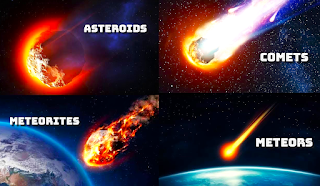Chapter: Stars and the Solar System - Class 8 Science
Introduction
➥ The moon is the brightest object in the night sky.
➥ All natural objects like the stars, planets, the moon, and many others in the sky are celestial objects.
The Moon
➥ The various shapes of the bright part of the moon as seen during a month are called the phases of the moon:
- New Moon day → When the moon is not visible.
- Full Moon day → When the full moon is visible.
➯ The gap between consecutive New Moon day and Full Moon day is about 15 days.
➯ The rotational period and revolution period of the moon are almost the same, around 29 days.
Moon's Surface
➥ Due to the lack of atmosphere, no sound can be heard on the moon.
➯ The moon is visible due to the reflection of sunlight.
The Stars
➥ All stars emit their own light. They appear small because they are far from the Earth.
➥ The sun appears larger because it is nearer.
➥ During the day, stars are not visible due to the bright sunlight.
➥ Stars appear to move from east to west due to Earth's rotation.
Constellations
➥ A constellation is a group of stars forming a recognizable shape. Some well-known constellations include:
- Ursa Major (The Great Bear or Saptarshi)
- Orion (The Hunter)
Solar System
→ The Sun and the celestial bodies which revolve around it form the solar system.
→ Sun is the nearest star from the earth.
→ It consists of a large number of bodies such as planets, comets, asteroids, and meteors.
→ The gravitational attraction between the Sun and these objects keeps them revolving around it.
Planets
→ Stars twinkle in the night sky, but planets do not.
→ Planets revolve around the sun along definite paths, called orbits.
→ Time taken by a planet to complete one revolution of its orbit is called the revolution period.
→ Time taken by a planet to rotate about its axis is called the period of rotation.
→ Satellites revolve around planets.
Inner Planets:
- Mercury:
→ Nearest planet to the sun.
→ It is seen just before sunrise and just after sunset near the horizon. It has no satellite. - Venus:
→ Nearest planet to the earth.
→ Brightest planet in the night sky.
→ Seen in the eastern sky before sunrise and in the western sky after sunset.
→ Also known as morning or evening star.
→ Has no satellite and rotates from east to west (sun rises in the west of Venus). - Earth:
→ From space, it appears blue because of 75% water content.
- Mars:
→ It appears reddish and therefore is known as the red planet.
Outer Planets:
- Jupiter:
→ Largest planet in the solar system.
→ Rotates very fast about its axis and has a large number of satellites. - Saturn:
→ Has a prominent ring system and a large number of satellites.
→ Its density is less than water and is the least among the planets. - Uranus and Neptune:
→ Both have a ring system.
→ Uranus has a tilted rotational axis and appears to roll on its side.
→ Uranus rotates from east to west similar to Venus.
Other Members of the Solar System
- Asteroids:
→ Small rocky objects found in large numbers between Mars and Jupiter.
- Comets:
→ Highly elliptical objects.
→ Have a bright head and long gaseous tail.
→ Tail is always directed away from the sun.
→ Halley’s comet appears after every 76 years.
Meteors & Meteorites
→ Objects that enter the earth’s atmosphere and burn because of friction with the atmosphere.
→ Large meteors that reach the earth’s surface are called meteorites.
Artificial Satellites
→ Revolves around the earth.
→ Used for weather forecasting, remote sensing, communication systems, etc.
Subscribe to My Channel













No comments:
Post a Comment